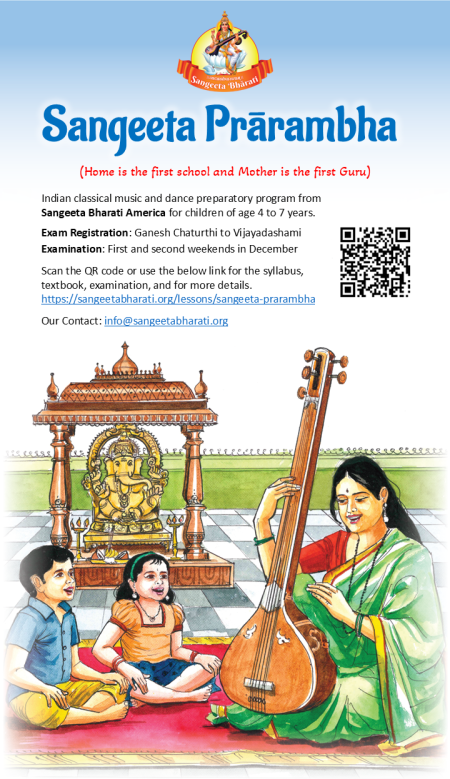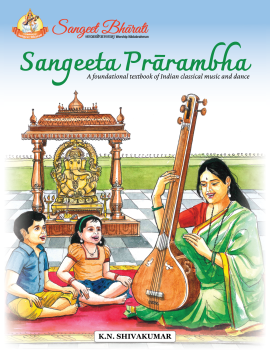Sangeeta Prarambha
Indian classical music and dance preparatory program for preschoolers and elementary schoolers
Prarambha (A Start) is a program devised by Sangeeta Bharati to engage children in learning and practicing Indian culture and art from early in their childhood. This program caters to children in elementary school who might not be ready yet for formal Indian classical music or dance education.
This program is created based on the principle that “Home is the first school and Mother is the first Guru“. Hence, these can be taught at home with no or little support for learning aids.
Advantage of Prarambha
1. The daily life of a child of Indian origin has a minimum of Yoga, Ayurveda (healthy eating), and Music/Dance along with regular academic activities and sports. The Prarambha curriculum touches upon these elements of a child’s learning ecosystem.
2. Having a goal is a good thing. Prarambha provides measurable progress for a child with a minimum target set.
3. Sangeeta Bharati rewards the children who are completing Prarambha (any level or all levels) with motivational rewards and recognitions in the form of certificates and prizes during its Navaratri annual event.
4. Children get an opportunity to chant/sing during Navaratri public events and other Sangeeta Bharati platforms.
5. Children will be able to proudly showcase their learning in front of loving and caring examiners.
6. Prarambha is the most excellent gift parents can ever give to their children.

Features of Prarambha Contest
1. The curriculum set here is the minimum expected from a child in the examination at a given age.
2. The curriculum is cumulative. Meaning, that if a 4-year-old has to learn 5 shlokas and 5 year old is 10, a five-year-old is expected to remember those 5 learned in the previous year and add a new 5.
3. Perfect pronunciation is not expected in the levels 1 and 2. But it is important in levels 3 and 4.
4. Stutis are hymns in praise of gods, goddesses, gurus, parents, nature, etc.,
5. Shlokas/Mantras are the hymns and are part of rituals like snaana shloka, suryanamaskara mantras, yoga shlokas (including suryanamaskar starting and ending shlokas), bhojan mantra, shanti mantra, etc.
6. Like any other Sangeeta Bharati examination, there are no predefined items to practice. Parents are free to select items of their choice under the categories given.
7. The lessons had to be memorized for the exam. No books or any materials are allowed.
8. It is advised for children to start at an early age (say from 4) and take exams each year and get evaluated. This brings in the discipline of learning progressively instead of catching up at any one higher level.
Sangeeta Prarambha Textbook

Sangeeta Prarambha textbook contains materials suitable for children up to 7 years old and to be taught by parents at home. This prepares a child for formal Indian classical music and dance lessons later. This book is for every child in every home irrespective of their classical music inclination. Use this as a textbook to appear for the Sangeeta Bharati examination in December and qualify to participate in Sangeeta Bharati Navaratri Sangeetotsav and other programs.
Sangeeta Prarambha is periodically updated and we announce the new editions of this book whenever available on our Facebook page. You can follow us on Facebook for updates at https://www.facebook.com/SangeetaBharatiAmerica/.
Sangeeta Prarambha contests don’t need the contents from this book to be used. Students and parents are free to select their own as per the prescribed syllabus.
Contest Details
- Duration: 30 minutes for ages 4 and 5 and 45 minutes for ages 6 and 7.
- Registration: From Ganesh Chaturthi to Vijayadashami every year.
- Registration with late fee: Until November 15th.
- Registration link: https://sangeetabharati.org/examinations/contest-registration/
- Certificate of completion and prizes: Sangeeta Prarambha Chaturtha (Level 4) will receive Sangeeta Prarambha certificate along with cash prize (1st prize: 4 times the examination fee. 2nd prize: 3 times the examination fee. 3rd prize: 2 times the examination fee) by Sankranti, the following year. All other levels will receive a certificate on the same day.
- Performing opportunities: Dallas Navaratri Sangeetotsav, the following year, and the events organized by Sangeeta Bharati America throughout the year.
Curriculum
Prarambha Prathama (Level 1)
1. Sanskrit Shloka/Stutis – 3.
2. Shloka in parent’s/ancestors’ language – 2.
3. Dainandina (daily) shloka/mantra – 2 (e.g., snaana mantra, bhojan mantra).
4. Nursery rhymes in Sanskrit – 2 (e.g., Nottuswaras)*
5. A small story from Ramayana.
6. A small story from Mahabharata.
Prarambha Dwiteeya (Level 2)
1. Sanskrit Shloka/Stutis – 5.
2. Shloka in parent’s/ancestors’ language – 3.
3. Dainandina (daily) shloka/mantra – 5 (e.g., snaana mantra, bhojan mantra).
4. Nursery rhymes in Sanskrit – 4 (e.g., Nottuswaras)*
5. Bhajan – 2 (e.g., Ganesha Pancharatna).
6. A five minutes story from Ramayana.
7. A five minutes story from Mahabharata.
Prarambha Trueeya (Level 3)
1. Sanskrit Shloka/Stutis – 5.
2. Shloka in parent’s/ancestors’ language – 3.
3. Dainandina (daily) shloka/mantra – 5 (e.g., snaana mantra, bhojan mantra).
4. Bhajans 2 (e.g., Ganesha Pancharatna).
5. Nursery rhymes in Sanskrit – 6 (e.g., Nottuswaras)*
6. A five minutes story from Ramayana with characters and places pronounced properly.
7. A five minutes story from Mahabharata with characters and places pronounced properly.
8. General knowledge: Calendar in Sanskrit. Indian festivals, sacred rivers, great epics, etc.,
9. One set of Suryanamaskar with 13 mantras and starting/ending shlokas.
Prarambha Chaturtha (Level 4)
1. Sanskrit Shloka/Stutis – 5.
2. Shloka in parent’s/ancestors’ language – 3.
3. Dainandina (daily) shloka/mantra – 5 (e.g., snaana mantra, bhojan mantra).
4. Bhajans – 3 (e.g., Ganesha Pancharatna).
5. Nursery rhymes in Sanskrit – 8 (e.g., Nottuswaras)*
6. A five minutes story from Ramayana with characters and places pronounced properly.
7. A five minutes story from Mahabharata with characters and places pronounced properly.
8. General knowledge: Calendar in Sanskrit. Indian festivals, sacred rivers, great epics, the Greatness of Hinduism, etc.,
9. One set of Suryanamaskar with 13 mantras and starting/ending shlokas.
10. Indian kitchen for healthy living (Ayurveda): Benefits of green curry leaves, Tulasi, spices from India like pepper, turmeric, and turmeric powder, benefits of good eating habits (including sitting on the floor), castor oil massage for tired legs from evening playing, etc.
11. Bhagawad Gita chapter 12 (Bhagawad Gita book from Sangeeta Bharati can be used. The download link is https://www.sangeetabharati.org/lessons/bhagawad-gita/).
*Swaras (musical notes) are optional. If Nottuswaras are selected, one can refer to the Nottuswara Sahitya book from Sangeeta Bharati at https://sangeetabharati.org/download/nottuswara-sahitya/.
Recommended Practice
1. Pooja room at home is the ideal place to practice these lessons.
2. Children should gather in the pooja room every evening after washing their face and feet or even a quick shower is ideal. Lit the oil lamp and then practice.
3. A group of children from the same neighborhood/subdivision gathering in one home and practicing these lessons is even more fun.
4. These chantings should be made part of our activities rather than isolated learning. The mantras should be inculcated in daily rituals. For example, Suryanamaskar should be practiced and chant the mantras and shlokas associated with it. Chanting snaana mantra before the start of the bath or bhojan mantra before bhojan or teertha mantra at a temple while receiving teertha is more impactful than chanting alone.
